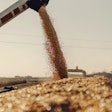
Depending on what part of the country you live in, you may hear Price Later (PL), Delayed Price (DP), or No Price Established (NPE). All of these terms describe the same type of contract: The farmer gives legal title of the grain to the commercial grain handler upon delivery, and has the option of waiting for some amount of time afterward to set the price and basis. We’ll refer to it as PL for this column.
Why PL Fees vary so much
The fee charged for this service can vary greatly from year to year or even month to month. There are a few market forces that cause this variation: volume, spreads, and basis. These factors are all directly related to the grain merchandising margin for the grain handler.
- Volume: Is there plenty of space to hold all the PL bushels? If so, PL Fees will not need to be high. You typically see this in summer when there isn’t much crop left and there is plenty of empty space, and many grain buyers will offer free PL. On the other hand, when there is a lot of crop to handle and it is overwhelming the amount of space available in a market, PL Fees can get very high. This is what we see in years with large old crop carryover and/or bumper crops that get harvested quickly.
- Spreads: Another more specific factor of what determines PL Fees is spreads in the futures market. As a general rule, large carries mean larger PL Fees and flat or inverted markets mean lower PL Fees or even Free PL. This is due to simple opportunity cost. If the market is paying a carry (deferred futures month is more than nearby futures month), then anyone who has the ability to buy and hold grain for that amount of time can collect that difference. In a PL scenario, the owner of the space fore goes that opportunity because the farmer doesn’t allow him to buy the grain that he is using his space for and must charge accordingly.
- 基础:这PL费用是一个数值repre的原因sentation of the volume discussion we had above. If basis is -50 at harvest and -10 for delivery two months after harvest, the elevator has an arbitrage opportunity to make 40 cents on bushels it buys that day and sells for two months after harvest. If the elevator instead allows a farmer to PL in his space, he cannot make that margin. Therefore, he must charge more. If basis is very high at the time the farmer enters into a PL contract, the PL Fees will be lower.

How elevators lose money charging PL Fees
There are two common misconceptions related to PL that can be dangerous to a grain elevator’s profitability if the grain merchandiser believes them:
- PL allows you to sell all you want at harvest and make space for more grain.While it is true that you do have legal title to the grain and can move it without having any legal ownership fears, selling PL bushels at harvest can be a recipe for disaster financially. As a grain elevator that profits from basis changes, selling the lowest basis of the season at harvest can pretty much guarantee a loss on those bushels in most years. A good grain merchandiser must manage his position in a way that will keep him from ever having to sell PL bushels at low harvest basis levels.
- The PL Fee guarantees the elevator will profit on PL bushels in the amount of the PL Fee.Many look at the PL Fee as a guaranteed margin on the bushels because they are charging for all or most of the opportunity cost on their space. However, this fee usually only covers all or most of the basis loss incurred if you have to sell the low harvest basis.
Let’s discuss a real-world example of this. During harvest (early October) of last year, the bid for soybeans to a large river market was -10 November futures and the bid for December delivery soybeans was +40 January futures. There was also an 8-cent carry in NOV/JAN soybean futures. This translated to a 58-cent difference in harvest basis and post-harvest basis as illustrated in Chart 1.
Many look at the chart and rightly determine that their space is worth 58 cents if they can buy the bushels at harvest and hold them until December. So, let’s say they charge a 58-cent minimum as a result (which would be difficult to do in most areas of the country). They would only make that PL fee as a profit if they held the bushels in their space and didn’t move them. However, if an elevator sells PL bushels at the harvest basis and then must buy those bushels in December when the farmer prices them, the elevator would lose 58 cents on this transaction. Thus, the 58-cent charge only covers their basis loss and the elevator profits nothing. If the elevator charged less than the 58-cent basis risk, they would lose money on the bushels.
One could make the argument that in a year like this one, it would make sense for an elevator to charge a $1.16 minimum PL Fee to cover the 58-cent basis risk as well as the 58-cent opportunity cost of what the space is worth. We all know that won’t happen, so …
What’s the best way to manage PL bushels at harvest?
- Be aware of the large risk of moving PL bushels at harvest
- Charge for all of the basis risk associated with PL bushels
- Set an internal limit on how much PL you will allow in your space before switching to cash only
- Stick to your plan!






















